自分を中心に据えてみると
普通に認識していた空間が違って見える瞬間を考えていた。
認識する側、すなわち自分が立ち止まっているか、動いているか、動いていれば場面が転換していくので、その転換ごとに場面を認識するだろう。それはまるで舞台の上のセットのように、それはわかりやすい、セットが転換すればストーリーも変わる。この場合、ストーリーは日常の暮らしに言い換えてもいいだろう。動くごとに日常の暮らしが場面転換し、その都度、空間を含めた日常を認識していく。
では、立ち止まっている時はどのように認識しているか、自分は動かない、でも何かを決起に認識していく、その何かはもしかしたら日常の暮らしそのものかもしれない。ならば、立ち止まった自分を中心に据えて空間を構築してみると、日常の暮らしが直に空間に現れてくるような気がした。
"When you put yourself in the center"
I was thinking of the moment when the space that I normally recognized looks different.
The recognizing side, that is, whether you are stationary, moving, or if you are moving, the scene changes, so you will recognize the scene at each change. It's like a set on the stage, it's easy to understand, and when the set changes, the story changes. In this case, the story could be translated into everyday life. Every time you move, your daily life changes scenes, and each time you recognize your everyday life, including space.
Then, when I'm stopped, I don't move, I recognize something when I stop, but I think that something is the everyday life itself. Then, when I tried to build a space centered on myself who stopped, I felt that everyday life would immediately appear in the space.


